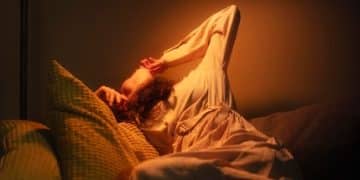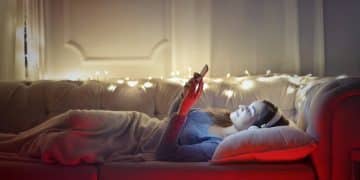Blue Light’s Impact: Sleep, Eye Health & Exposure Reduction Tips
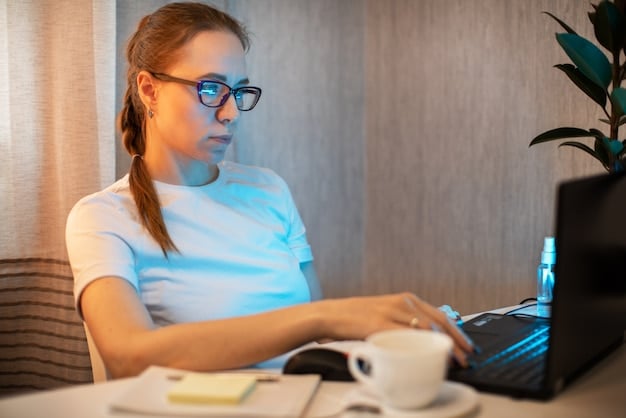
The impact of blue light on sleep and eye health is significant, affecting circadian rhythms and potentially leading to digital eye strain; practical tips for reducing exposure include using blue light filters, adjusting screen brightness, and taking regular breaks.
In our increasingly digital world, the impact of blue light on sleep and eye health: practical tips for reducing exposure has become a growing concern. From our smartphones to our computer screens, we are constantly surrounded by this high-energy visible light. But what exactly is blue light, and how does it affect our well-being?
Understanding Blue Light: What Is It?
Blue light is a type of visible light with short wavelengths and high energy. It’s emitted by the sun, as well as artificial sources such as LED and fluorescent lighting, and digital screens like smartphones, tablets, and computers. While natural blue light from the sun helps regulate our sleep-wake cycle and boosts alertness, excessive exposure to artificial blue light, particularly in the evening, can disrupt these natural processes.
The prevalence of digital devices in modern life means that we’re exposed to blue light more than ever before. Understanding its properties and effects is the first step in mitigating its potential negative consequences.
Sources of Blue Light
- Sunlight: The primary source of blue light.
- Digital Screens: Smartphones, tablets, computers, and televisions.
- LED and Fluorescent Lighting: Commonly used in homes and offices.
Understanding where blue light comes from is vital for identifying ways to minimize our exposure, especially during times when it can be most disruptive to our sleep patterns.
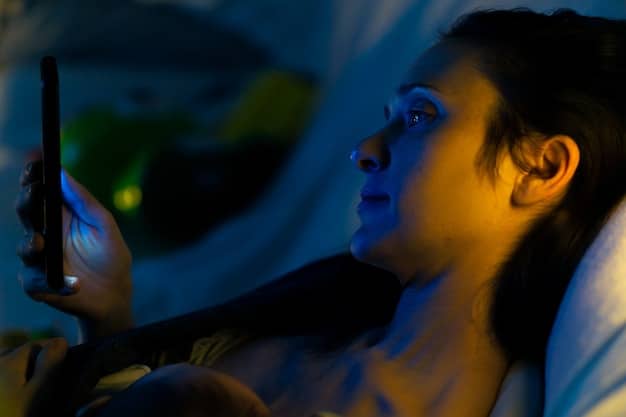
The Effects of Blue Light on Sleep
One of the most significant impacts of blue light is its effect on sleep. Exposure to blue light can suppress the production of melatonin, a hormone that regulates sleep. This suppression can make it harder to fall asleep and reduce the overall quality of sleep.
The disruption of melatonin production is particularly problematic when using digital devices close to bedtime. Since blue light mimics daylight, our brains become more alert, delaying the onset of sleep.
Melatonin and Sleep Disruption
- Melatonin Suppression: Blue light inhibits melatonin production.
- Delayed Sleep Onset: Makes it harder to fall asleep.
- Reduced Sleep Quality: Results in less restful sleep.
These effects can lead to a cycle of sleep deprivation, impacting overall health and well-being. Recognizing the link between blue light and sleep is crucial for adopting strategies to minimize its disruptive effects.
Impact on Eye Health: Digital Eye Strain
In addition to its effects on sleep, blue light is also linked to eye strain and other vision problems. Digital eye strain, also known as computer vision syndrome, is a common condition among people who spend extended periods looking at digital screens.
Symptoms of digital eye strain include dry eyes, blurred vision, headaches, and neck pain. Blue light contributes to this condition by causing increased glare and reduced contrast, requiring the eyes to work harder to focus. Moreover, some research suggests that long-term exposure to blue light may increase the risk of age-related macular degeneration.
Symptoms of Digital Eye Strain
- Dry Eyes: Reduced blinking rate leads to dry eyes.
- Blurred Vision: Difficulty focusing on near objects.
- Headaches: Strain from prolonged screen time.
Mitigating the impact of blue light on eye health involves a combination of lifestyle adjustments and technological solutions. Awareness and proactive measures can make a significant difference in reducing discomfort and potential long-term damage.
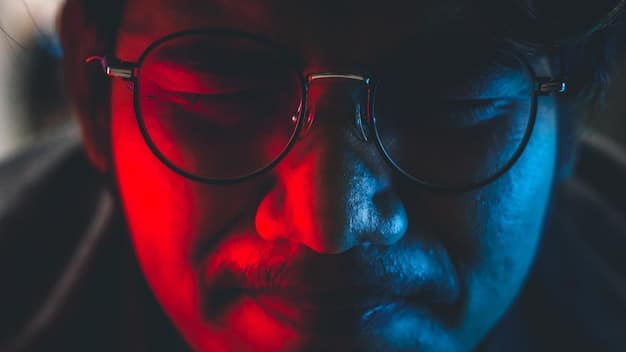
Practical Tips for Reducing Blue Light Exposure
Reducing exposure to blue light can significantly improve sleep quality and eye health. There are several practical steps you can take to minimize your exposure, especially during the evening hours.
These tips range from simple lifestyle changes to the use of blue light filtering technology. By incorporating these strategies into your daily routine, you can mitigate the adverse effects of blue light exposure.
Use Blue Light Filters
Blue light filters are available as screen protectors, software applications, and specialized glasses. These filters block or absorb a portion of the blue light emitted by digital devices.
Screen protectors and software applications can be installed on smartphones, tablets, and computers. Blue light blocking glasses are particularly useful for those who spend extended periods in front of screens.
Adjust Screen Brightness
Reducing the brightness of your digital screens can also help minimize blue light exposure. Lowering the brightness makes the screen less intense and reduces the amount of blue light emitted.
Adjust the brightness to a comfortable level, especially in dimly lit environments. Many devices also have automatic brightness settings that adjust based on ambient lighting conditions.
Take Regular Breaks
The 20-20-20 rule is an effective way to reduce eye strain. Every 20 minutes, look at an object 20 feet away for 20 seconds. This helps to relax the eye muscles and reduce fatigue.
Taking regular breaks can also reduce overall screen time, further minimizing exposure to blue light. Encourage short breaks throughout the day, especially during long work sessions.
Optimizing Your Environment
In addition to the use of blue light filters and adjustments to screen brightness, optimizing your environment can further reduce blue light exposure. Changing your lighting and creating a sleep-friendly atmosphere can make a big difference.
Consider the type of lighting you use in your home and adjust your habits to promote better sleep and eye health. By creating a balanced environment, you can minimize the impact of artificial light.
Adjusting Room Lighting
- Use Warm Light Bulbs: Replace cool, blue-toned light bulbs with warm, amber-toned ones, particularly in the evening.
- Dim the Lights: Lower the intensity of your lights as bedtime approaches.
- Avoid Bright Lights Before Bed: Bright lights can suppress melatonin production.
These steps can help create a more natural and sleep-conducive environment. A well-lit space during the day combined with dim, warm lighting at night promotes a healthier circadian rhythm.
Advanced Strategies and Tools
For those looking to take additional steps, several advanced strategies and tools can help further reduce blue light exposure. These include specialized software, advanced eyewear, and lifestyle modifications.
By leveraging these advanced tools and strategies, individuals can customize their approach to blue light reduction and tailor it to their specific needs and lifestyles.
Blue Light Reduction Software
Several software applications are designed to automatically adjust the color temperature of screens based on the time of day. These applications gradually reduce the amount of blue light emitted as the evening progresses.
Popular options include f.lux, Night Shift (available on iOS devices), and Blue Light Filter (available on Android devices). These tools can make a significant difference in reducing blue light exposure without requiring manual adjustments.
Blue Light Blocking Glasses
While standard blue light blocking glasses can be effective, advanced options offer even greater protection. These glasses often feature coatings that block a higher percentage of blue light.
Some glasses are designed for specific purposes, such as gaming or extended computer use. Consulting with an eye care professional can help you choose the right type of glasses for your needs.
Resetting Your Sleep Schedule
In addition to reducing blue light exposure, resetting your sleep schedule can further improve sleep quality. Consistency is key to regulating your body’s natural sleep-wake cycle.
- Maintain a Consistent Sleep Schedule: Go to bed and wake up at the same time every day, even on weekends.
- Create a Relaxing Bedtime Routine: Engage in calming activities such as reading or meditation before bed.
- Avoid Caffeine and Alcohol Before Bed: These substances can disrupt sleep patterns.
By combining blue light reduction strategies with a consistent and healthy sleep routine, you can achieve significant improvements in sleep quality and overall well-being.
| Key Point | Brief Description |
|---|---|
| 💡 Blue Light Defined | Visible light with short wavelengths affecting sleep and eyes. |
| 🌙 Sleep Disruption | Blue light suppresses melatonin, delaying sleep onset. |
| 👓 Eye Strain | Causes digital eye strain with symptoms like dry eyes and blurred vision. |
| 🛡️ Protection Tips | Use filters, adjust screen brightness, and take regular breaks. |
Frequently Asked Questions
▼
Blue light is a high-energy visible light with short wavelengths emitted by the sun, digital screens, and LED lighting. It affects sleep and eye health, making it a key concern in our digital age.
▼
Blue light suppresses melatonin production, a hormone that regulates sleep-wake cycles. This suppression can make it harder to fall asleep and reduce overall sleep quality, especially before bedtime.
▼
Digital eye strain includes symptoms like dry eyes, blurred vision, and headaches, often caused by prolonged screen time. Blue light contributes by increasing glare and reducing contrast, forcing the eyes to work harder.
▼
Practical tips include using blue light filters on screens, adjusting screen brightness to lower levels, taking regular breaks using the 20-20-20 rule, and adjusting room lighting with warmer tones.
▼
Yes, blue light blocking glasses can be beneficial, especially for those who spend extended periods in front of digital screens. They help reduce eye strain and minimize blue light’s impact on sleep patterns, promoting overall well-being.
Conclusion
In conclusion, understanding and mitigating the impact of blue light on sleep and eye health: practical tips for reducing exposure is crucial in our digitally driven world. By implementing the strategies discussed, from using blue light filters to optimizing your sleep environment, you can significantly improve your well-being and protect your long-term health.
